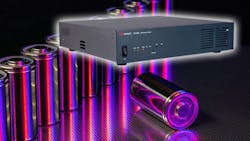Can EIS Measure Self-Discharge of a Lithium-Ion Battery Cell? (Download)
Self-discharge is a normally occurring phenomenon in lithium-ion battery cells. A normal cell may have a self-discharge rate of 1% state of charge (SOC) per month. The normal self-discharge rate is determined by the temperature of the cell, the SOC, and the electrode materials, while excessive self-discharge is indicative of a faulty cell.
This fault could be due to issues with the electrode or electrolyte materials, undesirable metal particles contaminating the cells, problems with the separator, or the growth of dendrites. Such faults can be induced poor control of the manufacturing process, by over-charging or over-discharging the cell, or by excessive heating. Click here to view an interesting story regarding an unexpected root cause of self-discharge.
